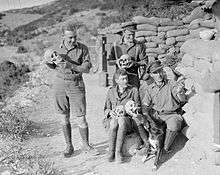Lion of Amphipolis
Coordinates: 40°48′11″N 23°50′33″E / 40.80311°N 23.842601°E

The Lion of Amphipolis is a 4th-century BC tomb sculpture in Amphipolis, Macedonia, northern Greece. According to the first person excavating in the area in the 1960s, archaeologist Dimitris Lazaridis, it was set up in honor of Laomedon of Mytilene, an important admiral of Alexander the Great.
History
The finding of the monument is connected to the modern history of Macedonia in Greece, as the first parts of it were found initially by Greek soldiers during the Second Balkan War that had camped in the area during 1912 - 1913. They were followed by British soldiers a few years later in 1916 during World War I who also discovered significantly large parts of the monument. In the early 1930s during works for drying part of the Lake Kerkini nearby, there was a discovery of an ancient bridge and close to it within the mud of the river further very large pieces of the marble lion. In 1937, and thanks to Lincoln MacVeagh the US ambassador in Greece at the time, there was a private initiative along with support and funds from the Greek government to restore the Lion of Amphipolis, which eventually came to be in its current form. The whole process has been documented thoroughly by Oscar Broneer in his book 'The Lion of Amphipolis' published in 1941.
Description
Although in sited position, the lion is larger and bulkier than the one erected at Chaeronea, has a height of more than 4 meters in its main body and taking into account the base it is taller than 8 meters. The head has a width of 2 meters. Its craftsmanship shows a work of the 5th or first half of 4th century B.C.. As to when it was erected there is no agreement between experts as no mentioning of it in ancient sources.
There was recent speculation that the lion used to be on top of the Kasta Tomb.[1] but this theory has now been discounted.[2]
Gallery
-

Officers of the 2nd King's Shropshire Light Infantry with skulls excavated during the construction of trenches and dugouts at the site, 1916
-

Early excavations
-

view of the fragments before restoration
-

Part of the lion's head before restoration
-

The imposing size of the lion in an early picture following its restoration
-

View of the base during reconstruction
-

Works conducted on the lion's base
-

Reconstructed statue in 1937
-

Historic photograph
References
- Citations